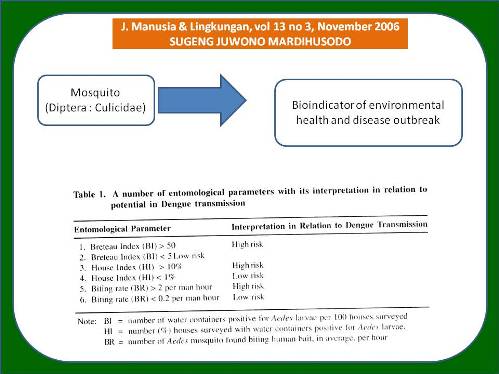
MOSQUITO (DIPTERA: CULICIDAE) AS A BIOINDICATOR OF ENVIRONMENTAL HEALTH AND DISEASE OUTBREAK
Sugeng Juwono Mardihusodo(1*)
(1) Department of Parasitology Faculty of Medicine Center for Environment Studies Gadjah mada University, Yogyakarta
(*) Corresponding Author
Abstract
Quality of public health is
greatly influenced by a lot of environmental factors, especially biotic
factors among wich is a group of hematophagus mosquitoes (Diptera:
Culicidae) showing high competence as disease vector(s). The vector
mosquitoes belong to different species of different genera: *Anopheles,
Aedes, Culex*, and *Mansonia.*In hypersensitive individuals, mosquito bites
may induce pain and itching on the skin where the mosquito suck blood,
allergic dermatitis leads up to dermatosis, even persistently, causing
nuisance. Through the mosquito bites, man may risk to being infected with
pathogens causing Malaria, Dengue Haemorrhagic Fever (DHF), Chikungunya,
Japanese Encephalitis (JE), and Lymphatic filariasis, specifically in areas
where the mosquito-borne disease (MBD) is (are) endemic. Survival of a
mosquito vector species of disease vector is much dependent on its
environment, mainly on the availability of a number of suitable habitats
for its pre-adult stages, larvae and pupae. Number, type and size of the
larval habitats as well as quality of water in the mosquito breeding places
apparently determine rates of survival and density of the mosquito breeding
in it which generally positively correlate with the increase of the MBD
transmission. Therefore, mosquito mainly a disease vector could be used as
one of the bioindicators of environment health and its significant increase
in density is predictive of the probable occurrence of a MBD epidemic in a
communityliving in an endemic area.
Full Text:
Artikel lengkap (PDF)Article Metrics
Refbacks
- There are currently no refbacks.
Copyright (c) 2017 Jurnal Manusia dan Lingkungan







